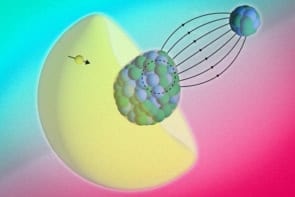
A major upgrade programme at the European Synchrotron Radiation Facility (ESRF) in Grenoble, France, is nearing completion as a suite of new beamlines is brought in to operation. When fully complete by the end of 2015, the €166m refit, which began in 2009, will offer scientists unique capabilities for probing the atomic structure of materials.
Operated by 20 member and associate countries, the ESRF generates X-rays by forcing electrons to travel around a 0.8 km-circumference storage ring at near-light speeds. Some 40 beamlines fan out tangentially from the ring, focusing the X-rays down to intense, sub-micron-diameter beams that allow scientists to carry out research using X-ray imaging, spectroscopy and diffraction. Around 7000 researchers travel to the ESRF each year to perform experiments ranging from studies of advanced materials and searches for new drug targets to palaeontology and the preservation of priceless paintings.
Numerous synchrotrons have sprung up across the world since the ESRF came online 20 years ago, particularly in Europe, with users demanding ever brighter and smaller X-ray beams. “The upgrade of the ESRF goes along way towards strengthening Europe’s leadership in synchrotron science,” ESRF research director Harald Reichert told physicsworld.com.
Paving the foundations
In addition to numerous advances in instrumentation and improvements to the storage ring, the upgrade is based on the construction of 15 new and 4 refurbished beamlines. The first, which allows matter to be studied under extreme conditions, came in to service in late 2011, but now beamlines are coming onstream thick and fast. Two beamlines opened earlier this summer, with others to follow later this year.
Two major extensions to the ESRF’s experimental halls, which were inaugurated at the end of June, are the most visible sign of the upgrade so far. Building works began at the end of 2011 and required 50,000 m3 of earth to be excavated in order to prepare the foundations for the monolithic concrete slab that forms the hall floor, which has to resist very heavy loads while being stable enough to allow samples to be aligned to within a few nanometres. Construction of four extended beamlines that will be housed in the new buildings are currently under way.
Entering a second phase
Now, the facility has launched a bid for a second phase of the upgrade that would allow the ESRF to reclaim its title as the world’s brightest synchrotron-radiation source. Estimated to cost in the region of €150m, the project would see the existing storage ring replaced with a new version that reduces the spread of the electron beam in the horizontal plane. In theory, this would boost the brilliance and coherence of the X-rays it can deliver to values never before achieved with a synchrotron-radiation source. “The upgrade programme of the ESRF is a big step towards diffraction-limited performance in the hard X-ray regime and opens a new chapter in X-ray science,” says Reichert.
A technical-design study for the second upgrade phase is expected to be complete in spring 2014. A final decision on whether to proceed with the programme will then be taken by the ESRF’s member states by late 2014, which would allow the new machine to enter operation by the end of the decade. “The plans for the next phase of the ESRF upgrade are tremendously exciting,” says Andrew Harrison, incoming chief executive of the Diamond Light Source – the UK’s national synchrotron facility – who is nearing the end of his term as director of the Institut Laue-Langevin neutron facility in Grenoble. “It offers step changes that promise to foster new science and strong European collaboration.”



